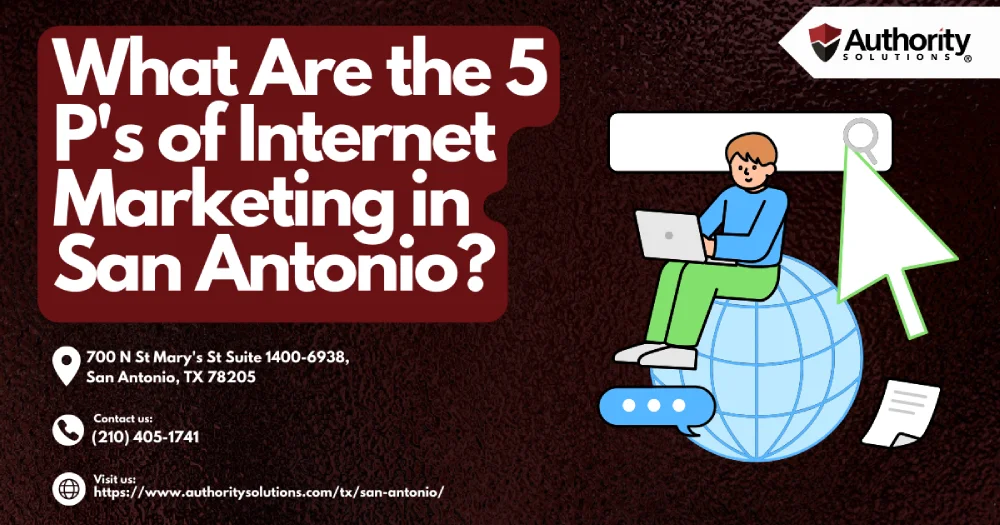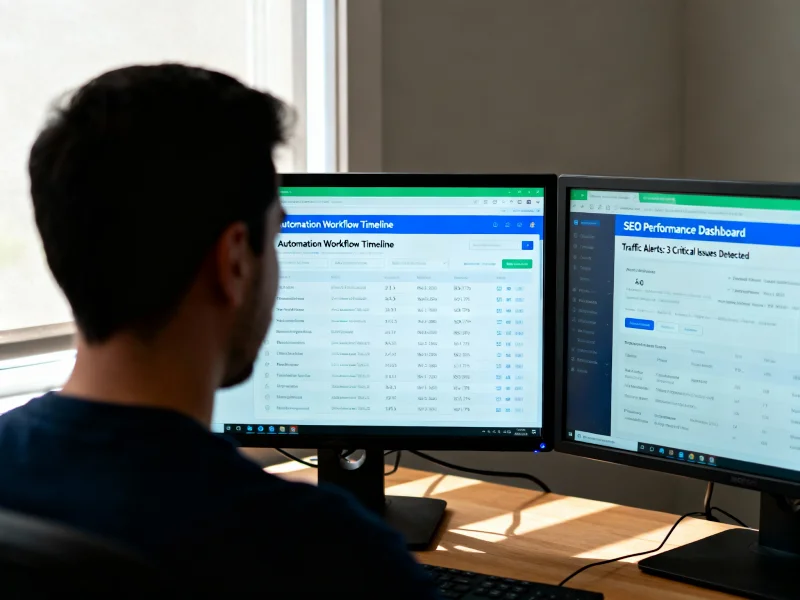What Are the 5 P's of Internet Marketing in San Antonio?
San Antonio’s tech corridor is booming, yet many small and medium-sized businesses still struggle to turn web clicks into paying customers. The classic “5 P’s” framework—Product, Price, Place, Promotion, and People—remains the fastest way to craft measurable marketing efforts that resonate with local shopper demographics while driving traffic to your site. This guide combines the latest trends in social media marketing, search engine optimization, and PPC with real-world case studies from the Alamo City, so you can generate stronger ROI, higher conversion rates, and long-term loyalty.
Key Takeaways
- Applying the Product, Price, Place, Promotion, and People framework helps San Antonio businesses align digital marketing with local behavior and demographics. Tailoring each “P” to fit the city's diverse audiences—from military families to bilingual communities—ensures more relevant messaging and stronger engagement across channels.
- Behind every effective campaign is a clear strategy: defined KPIs, budget allocations, and ownership of tasks. San Antonio marketers are encouraged to pair qualitative feedback with conversion data to adjust their pricing, promotions, and positioning before deploying paid campaigns, especially on tight budgets.
- Leveraging platform-specific strengths—Instagram Reels for visuals, LinkedIn for B2B, Google Ads for intent-driven traffic—makes digital spend more efficient. Incorporating local imagery, geo-targeting, and events like Fiesta strengthens community connection and increases ROI through relevance.
- While ads generate quick wins, SEO compounds over time. Technical health, local keyword targeting (like "best tacos in Stone Oak"), and backlinks from regional influencers improve visibility. Bilingual content and real case studies also boost credibility and appeal to broader San Antonio segments.
- Employees and satisfied customers are integral to trust-building. Encouraging reviews, sharing behind-the-scenes videos, and featuring client testimonials not only humanize the brand but also increase word-of-mouth referrals. This people-focused approach turns short-term buyers into loyal advocates.
Marketing
Before diving into tactical details, remember that marketing is broader than any single campaign or ad. It’s the ongoing initiative of understanding consumer behavior, outlining objectives, and aligning every message, platform, and call to action with your company’s business goals. In San Antonio, that means tailoring value to your audience—families stationed at Lackland, young professionals at The Pearl, and bilingual shoppers along Fredericksburg Road—so they take action instead of scrolling past.
Key action items to foster credibility upfront:
- Analyze website analytics weekly to ensure each page meets the needs of potential customers.
- Leverage high-quality video content shot at local landmarks to showcase products and services authentically.
- Automate SMS reminders for curbside pickup to turn online interest into physical foot traffic.
Marketing Strategies
Your chosen marketing strategies should give every dollar a purpose and every metric a clear KPI. Whether you prioritize lead generation through Google Ads, nurture loyalty via a newsletter, or spark word-of-mouth with TikTok challenges during Fiesta, craft a roadmap that aligns with both short-term conversion objectives and future campaigns aimed at expanding market share.
Fundamental tactics to integrate:
- PPC remarketing to attract shoppers who abandoned carts.
- Content marketing pillars—blogs, LinkedIn thought leadership, and SEO-rich pillar pages—to boost organic traffic.
- Marketing automation sequences that send personalized discounts when users hit predefined engagement thresholds.
Strategy
A strategy is the “why” behind every tactic. Outline measurable KPIs, allocate resources, and assign ownership so each team member understands how their tasks ladder up to company’s bigger picture. This disciplined approach allows you to pivot quickly—especially important for small businesses with limited budgets—while still delivering value to your audience.
Pro tip: Pair conversion data with qualitative feedback from Instagram polls to refine future positioning and pricing before launching the next ad set.
Marketing Plan
A detailed marketing plan turns strategic intent into an executable timeline. Include channel priorities, monthly spend, creative requirements, and the metrics that define success. For example, your plan might commit 40 % of budget to paid social, 30 % to SEO, 20 % to email, and 10 % to local partnerships—each mapped to the 5 P’s so you know which lever to pull when results plateau.
Checklist for San Antonio businesses:
- Set quarterly KPIs for lead generation and ecommerce revenue.
- Collaborate with neighborhood associations for hyper-local promotion.
- Document seasonality—Rodeo, Spurs playoff runs, graduations—to time promotional pushes.
Digital Marketing
Digital marketing is the engine that powers modern growth: PPC, social media, display, influencer collaborations, and video dominate local screens. To optimize ROI, consider platform-specific nuances. Facebook excels for community-building, Instagram Reels for visual storytelling, LinkedIn for B2B thought leadership, and Google Ads for high-intent searches like “emergency AC repair near me.”
Combine these channels with rigorous analytics so you can analyze CPC, CPA, and lifetime value. Then refine the mix to drive higher conversion and lower acquisition cost.
SEO
Search engine optimization is the silent workhorse that drives “free” traffic long after ads stop running. Focus on three pillars: technical health, high-quality content, and authoritative backlinks. In San Antonio, localized on-page SEO—think “best breakfast tacos in Stone Oak”—paired with consistent Google Business Profile updates helps your brand appear in the coveted map pack, attracting real-time mobile shoppers ready to buy.
SEO Tips:
- Optimize image alt tags with bilingual keywords to reach English and Spanish speakers.
- Create case studies that showcase measurable results, reinforcing credibility and boosting E-E-A-T signals.
- Partner with local bloggers to earn backlinks and word-of-mouth mentions.
Marketing Mix
The marketing mix traditionally covers Product, Price, Place, and Promotion. Modern internet marketing adds a fifth element—People. Below is a San Antonio-centric blueprint for balancing the 5 P’s to maximize conversion and market share.
Product
Whether you sell gourmet paletas or enterprise software, your product or service must meet a real need. Use analytics, surveys, and social listening to tailor features that resonate with local demographics—military families appreciate deployment holds, while downtown professionals value mobile ordering and one-hour delivery.
Price
Pricing signals value and positions your brand against competitors. Offer tiered packages, limited-time discount codes during Fiesta, and upfront transparent fees to foster trust. Track AOV, discount redemption, and margin to ensure profitability while satisfying budget-conscious shoppers.
Place
Place now refers to every digital doorway where customers can acquire your product. Optimize your website for one-click checkout, sync inventory with Google Shopping, and geotag Instagram posts so locals see you first. Seamless omnichannel presence ensures shoppers can buy wherever they scroll.
Promotion
Promotion blends organic and paid channels. Run geo-fenced Google Ads around UTSA during orientation week, launch influencer campaigns on TikTok featuring River Walk backdrops, and schedule newsletter bursts with clear calls to action. Monitor metrics like CTR, CPC, and ROAS to refine copy and creative.
People
Employees and customers are your most persuasive brand advocates. Train staff to request reviews after positive interactions, showcase satisfied clients in LinkedIn posts, and highlight behind-the-scenes stories in video content. Authentic human connection drives referral traffic and boosts customer lifetime value.
Target Audience
Every successful marketing mix starts with a clearly defined target audience. Use first-party data, social insights, and third-party research to segment buyers by age, income, language, and psychographics. In San Antonio, that might mean crafting separate campaigns for Spanish-speaking parents in the South Side and tech-savvy millennials in the Medical Center. Tailor messaging, imagery, and platform choice so each segment feels the offer was built just for them.
Effective steps to identify and reach potential customers:
- Leverage Facebook Audience Insights and Google Analytics demographics reports.
- Run A/B tests on ad copy to measure which value propositions resonate.
- Use marketing automation to send personalized follow-ups based on browsing behavior, increasing conversion rates by meeting the needs of each segment in real time.
By layering the 5 P’s onto disciplined marketing strategies, a thoughtful marketing plan, and data-driven SEO, San Antonio businesses can optimize every tactic for measurable growth. Remember: analyze KPIs continuously, adjust pricing and promotion in response to shopper feedback, and empower your people to keep the brand’s voice authentic. That synergy will turn one-time buyers into lifelong fans and expand your market share across South Texas.
Frequently Asked Questions
How do I choose the right digital platform for my San Antonio marketing campaign?
Start with your target audience’s preferred hangouts. Younger demographics flock to TikTok and Instagram Reels, professionals browse LinkedIn, and high-intent shoppers use Google. Analyze engagement metrics after small test spends on each platform, then allocate budget to the channels delivering the strongest ROI and lead generation.
Can the 5 P’s model work for B2B companies in San Antonio?
Absolutely. Product becomes your solution’s unique value, Price involves subscription tiers, Place includes your website and partner portals, Promotion spans webinars and PPC, and People involve sales reps and happy clients. When aligned, these elements shorten sales cycles and boost credibility with corporate buyers along the I-35 tech corridor.
What KPIs matter most for small businesses starting with PPC?
Focus on click-through rate, cost per click, and cost per acquisition during the first 30 days. Once you record sufficient data, shift attention to lifetime value and ROI. These metrics reveal whether your ads are not only driving traffic but also creating sustainable profits for future campaigns.
How often should I update pricing to stay competitive?
Review competitor rates and internal margin quarterly, but make micro-adjustments during peak seasons like Rodeo or Fiesta. Use analytics dashboards and A/B testing tools to analyze how each change affects conversion and shopper perception before locking in long-term pricing.
Is content marketing still effective when social algorithms keep changing?
Yes—high-quality, evergreen content anchors your SEO and provides share-worthy resources that algorithms tend to favor. Pair blog posts with video clips and infographics to diversify reach. Continual optimization keeps your authority strong, even as platforms evolve.
What role does SMS play in modern promotion?
SMS enjoys open rates above 90 %, making it ideal for flash discounts, appointment reminders, and loyalty rewards. Automate messages based on user behavior—like abandoned carts—to foster immediate action while integrating seamlessly with email and push-notification flows.
How can I use analytics to improve future campaigns?
Set up dashboards that track traffic sources, on-page behavior, and conversion funnels. Compare performance against benchmarks, segment data by demographics, and conduct cohort analysis. These insights pinpoint which messages resonate, allowing you to optimize creative, placement, and budget allocation for higher ROI.
Are Google Ads or Facebook Ads better for lead generation?
Google Ads capture high-intent searches, delivering quick conversions for urgent services. Facebook Ads excel at interest-based targeting and nurturing awareness. Most San Antonio businesses find that a blended approach—Google for bottom-funnel intent and Facebook for top-funnel education—maximizes overall lead generation.
What’s the simplest way to boost credibility online?
Collect and showcase testimonials. Encourage satisfied customers to leave Google reviews, then feature those snippets on landing pages and LinkedIn posts. Pair social proof with case studies that document measurable results to reinforce your brand’s authority.
How do partnerships amplify promotion in the local market?
A strategic partnership—such as co-hosting a webinar with a complementary brand or bundling a discount with a nearby restaurant—extends reach to a pre-qualified audience. Shared resources lower acquisition costs, while combined credibility fosters trust among both customer bases, accelerating conversion and fostering long-term loyalty.










